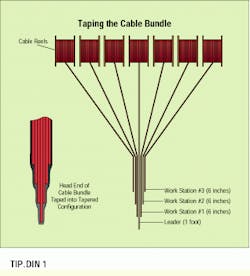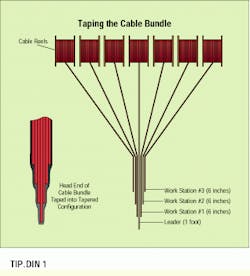Grouping cables for pulling
Rick Maio, Dinsmore Communications
Problem
When pulling cable into horizontal runs or snaking it through walls, you can save time and effort by simultaneously pulling as many cables as is practical. However, a large and bulky cable bundle can jam in a conduit, snag on turns or catch on a coupling. Clearing a jam or unsnagging the cable bundle may lead to cable damage or even breakage, especially with delicate Category 5 cabling.
Solution
To prevent cable-pulling problems, it is important to carefully prepare the head end of the cable bundle. Staggering the cables, taping them into a streamlined configuration, lubricating the head end of the cable bundle and carefully feeding the cable into the conduit or pipe can help prevent snags and jams.
Procedure
1) Plan the number and type of cables you are going to pull at one time. Is it going to be a tight fit? For example, on a recent job we pulled one coaxial cable and three twisted-pair cables through one-half-inch electrical metallic tubing: It was a tight fit.
2) Arrange your cable reels and boxes so the various cables will group in the configuration you have planned. Select one cable to be the leader. (If you are pulling several different cable types at once, the sturdiest makes the best leader.)
3) Group two or three cables--selected because they are going to a single work area--around the leader approximately one foot from the cable end. Spirally wrap the leader and the first group of cables with electrical tape. Make your taping sturdy to protect the underlying cable.
4) Arrange a second group of two or three cables approximately six inches back from the first grouping and wrap them with electrical tape. Where possible, fit the cables into grooves or depressions in the cable bundle, so its shape is as streamlined as possible. There should be no bulges that may hang up during pulling.
5) Continue to attach cables until you have as many in the bundle as you plan to pull. This number will depend on whether you are pulling by hand or winch, the size and length and route of the pulling path, and how many work areas are being served. Pulling 10 to 15 cables at a time is not unrealistic.
6) Attach the leader to a pullrope by slipknot, or to a mechanical snake. If appropriate, apply a pulling lubricant. Make sure the lubricant is liberally applied to the taped bundle head because this is the area most likely to encounter friction during the pull.
7) One installer then goes to the work-area end of the pull to hand-pull or winch the cable. A second installer gently feeds the cable bundle into the pipe, conduit or opening, making sure it does not bunch, snag or otherwise get damaged. The two installers should be able to communicate, be it by voice or radio.
8) Once the cable bundle is pulled out the other end, remove the pullrope or snake, and untape the bundle. Cut off the one-foot leader and discard it, because it will most likely be strained or damaged during the pull.
Arrange and tape the cables to be pulled so they form a tapered, streamlined bundle without bulges or edges.
Rick Maio is an installation supervisor for Dinsmore Communications, Portsmouth, NH.

